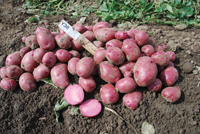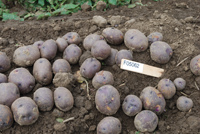
Features
Business & Policy
Consumer Issues
Colour should be skin-deep
Growers tapping into specialty markets for blue- or dark-skinned potatoes often find the skin colour fading the longer the tubers are in storage.
April 30, 2010 By Rosalie I. Tennison
Growers tapping into specialty markets for blue- or dark-skinned potatoes often find the skin colour fading the longer the tubers are in storage. Similarly, those growing the more common red varieties are also seeing colour changes. A researcher at the University of Idaho is trying to determine why this happens and if it can be prevented.

|
 |
| Colours that are very desirable to consumers can lose their vibrancy soon after harvest, during storage and after packaging, and researchers are beginning to explore why that happens. Photos by Ralph Pearce. |
Dr. Mike Thornton, who is with the research faculty at the Southwest Idaho Research and Extension Centre in Parma, says it is believed the colour of the skin is set at the beginning of tuber development, but that environmental factors can change pigmentation throughout the season. However, if the crop maintains its colour through to maturity, growers are finding the colour will fade during storage and after packaging. “Colour could be affected by disease, such as silver scurf, and colour can change due to oxidation or surface contamination,” Dr. Thornton comments. “We are looking at timing of harvest after kill down; if the period between the two operations is not long, colour could be preserved. We are also considering if cooling the potatoes quickly once they are put in storage could help preserve colour. Another consideration is whether the disinfectant used in the wash water could be causing fading.”
The last theory is being examined more closely by Dr. Thornton and his colleagues. Since growers use many types of disinfectants, all are being evaluated. “We are going to examine a variety of disinfectants to see which is the least invasive,” he explains. “Some varieties do fade less than others but is the fading encouraged by the disinfectant on the ones that fade more?”
The interest in dark-skinned potatoes is being spurred by the knowledge that the pigments in the skin have antioxidant properties. There is speculation that some of the benefits could be lost if the skin fades. Dr. Thornton says the small “baby” potatoes often have the most intense colour, making them a healthier choice, so preserving the colour will increase their “health appeal.” To launch the research, Dr. Thornton’s team planted six coloured skin varieties in spring 2009 and monitored the effects of growth regulators, in-season and post-season fungicides, harvest timing and, after harvest, began evaluating the disinfectants used and storage conditions.
Dr. Thornton evaluated the storage processes in late 2009 and expects to have results before spring 2010. Interim results from the research showed that the growth regulator 2,4-D increased the skin colour of both red cultivars and one blue/purple cultivar after storage. According to Dr. Thornton, this indicates that using this particular growth regulator will net results after storage but they are not apparent at harvest. Other growth regulators that gave some improvement in colour were napthaleneacetic acid (NAA) and NanoMax, but 2,4-D offered the most dramatic result.
Once the team has completed the evaluation of the research on harvest timing and disease control, Dr. Thornton believes some useful guidelines for specialty potato growers can be developed to help those wanting to maintain the colour of the crop.
Growers who want to maintain the colour of their dark-skinned potatoes to entice consumers to purchase them will no doubt be interested in Dr. Thornton’s results. If colour can be maintained simply by changing growing and storage practices, or disinfectants, growers will likely be pleased to make the change.